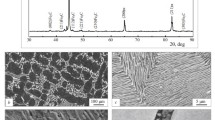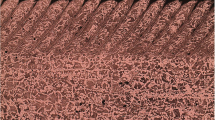Conclusions
-
1.
The carbon content affects softening during subsequent heating of cold-worked steels. With increasing carbon concentrations the hardening effect is retained after heating to higher temperatures.
-
2.
During subsequent annealing, cold-worked steels retain the hardening effect up to ∼ 10% deformation, which is due to polygonization and formation of a cellular structure.
-
3.
Softening of cold-worked steels depends on the original structure of the pearlite. Steels with globular cementite are less susceptible to softening in comparison with steels containing lamellar cementite.
Similar content being viewed by others
Literature cited
P. Funke et al., "Relationship between hot rolling conditions and recrystallization processes in coldworked rod steel," Chern. Met. No. 18, 3 (1972).
S. S. Gorelik, Recrystallization of Metals and Alloys [in Russian], Metallurgiya, Moscow (1967).
Additional information
Donets Scientific-Research Institute of Ferrous Metallurgy. Donets Polytechnical Institute. Translated from Metallovedenie i Termicheskaya Obrabotka Metallov, No. 4, pp. 21–22, April, 1979.
Rights and permissions
About this article
Cite this article
Pil'guk, V.E., Podgaiskii, M.S., Ikonnikov, V.I. et al. Effect of the original structure on softening of cold-worked steel during heating. Met Sci Heat Treat 21, 268–270 (1979). https://doi.org/10.1007/BF00775105
Issue Date:
DOI: https://doi.org/10.1007/BF00775105




